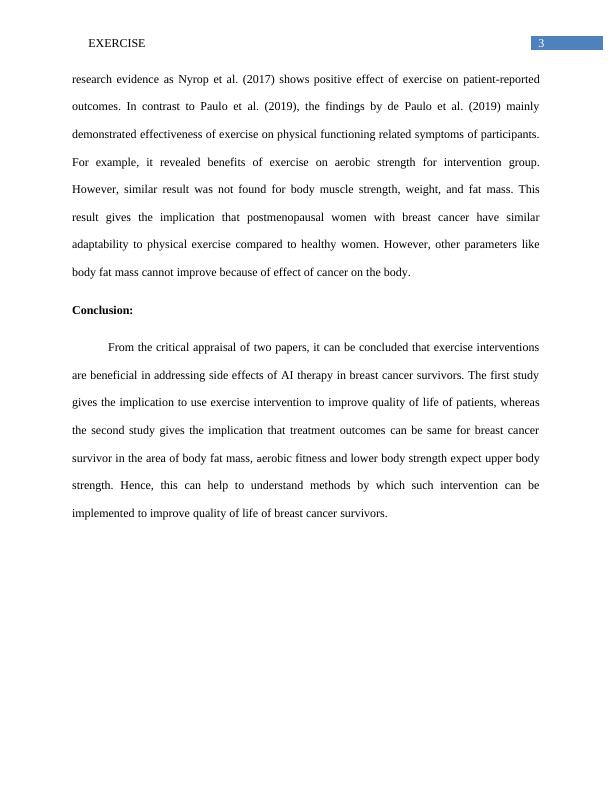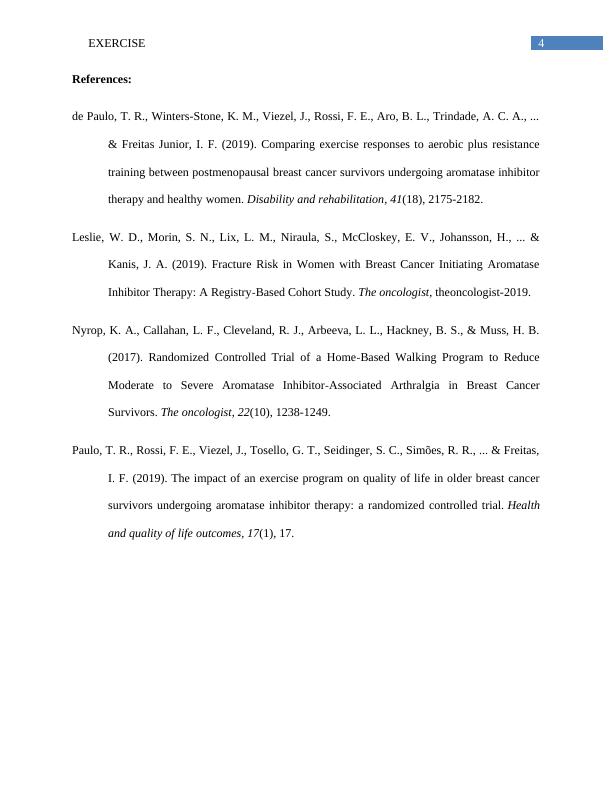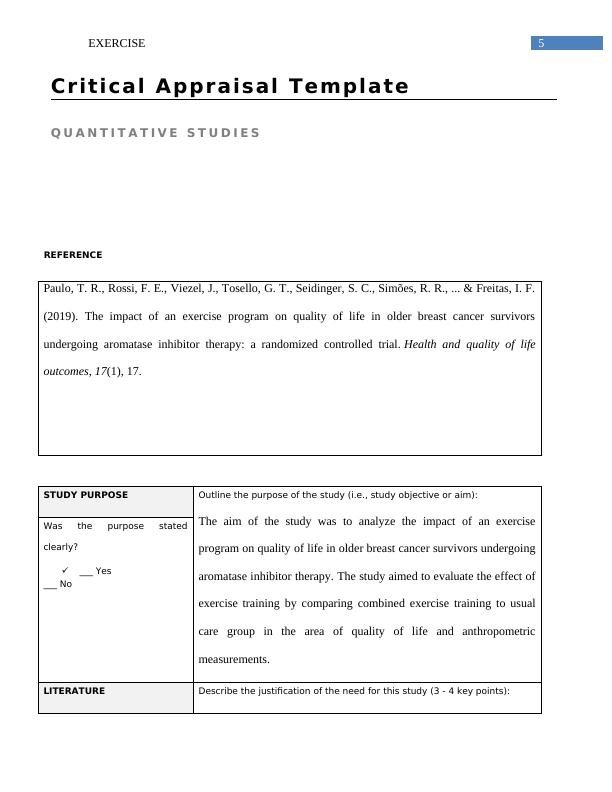Effectiveness of Exercise Intervention on Breast Cancer Survivors Undergoing Aromatase Inhibitor Therapy
Added on 2022-12-19
26 Pages4411 Words54 Views
Running head: EXERCISE
A critical appraisal on effectiveness of exercise intervention on breast cancer survivors
undergoing aromatase inhibitor therapy
Name of the student:
Name of the University:
Author’s note
A critical appraisal on effectiveness of exercise intervention on breast cancer survivors
undergoing aromatase inhibitor therapy
Name of the student:
Name of the University:
Author’s note

1EXERCISE
Introduction:
Aromatose inhibitor therapy is a highly used therapy for post-menopausal breast cancer
women as it works to reduce the estrogen level in patients. However, this therapy is associated
with side-effects such as loss of muscle strength, decrease in bone mineral density and increase
in risk of fracture (Leslie et al., 2019). For this reason, exercise intervention is required for
breast cancer survivors as it can promote physical, physiological as well as psychological health
of patients. The main clinical question for this critical appraisal is ‘what is the effectiveness of
exercise interventions for breast cancer patients receiving aromatose inhibitor therapy?’. The
main aim of this critical appraisal is to review two articles de Paulo et al. (2019) and Paulo et al.
(2019) relevant to the research question and compare the studies in terms of research rigor and
key findings obtained. The findings from this paper will have important implications for exercise
physiology practice as the critical appraisal will help to develop knowledge regarding the key
skills trainers and specialist need to have while supporting breast cancer survivors
Methods:
The research papers by de Paulo et al. (2019) and Paulo et al. (2019) both focused on
evaluating the effectiveness of exercise intervention in breast cancer survivors taking aromatose
inhibitor therapy. Both the studies used randomized controlled trial as a research design. Paulo et
al. (2019) randomized participants into two groups of resistance plus aerobic exercise training
groups and control group. In contrast, de Paulo et al. (2019) randomly assigned participants into
two groups of patients with breast cancer survivors and healthy individuals. The selection of
RCT as a research design in both papers are appropriate as RCTs are the most effective method
Introduction:
Aromatose inhibitor therapy is a highly used therapy for post-menopausal breast cancer
women as it works to reduce the estrogen level in patients. However, this therapy is associated
with side-effects such as loss of muscle strength, decrease in bone mineral density and increase
in risk of fracture (Leslie et al., 2019). For this reason, exercise intervention is required for
breast cancer survivors as it can promote physical, physiological as well as psychological health
of patients. The main clinical question for this critical appraisal is ‘what is the effectiveness of
exercise interventions for breast cancer patients receiving aromatose inhibitor therapy?’. The
main aim of this critical appraisal is to review two articles de Paulo et al. (2019) and Paulo et al.
(2019) relevant to the research question and compare the studies in terms of research rigor and
key findings obtained. The findings from this paper will have important implications for exercise
physiology practice as the critical appraisal will help to develop knowledge regarding the key
skills trainers and specialist need to have while supporting breast cancer survivors
Methods:
The research papers by de Paulo et al. (2019) and Paulo et al. (2019) both focused on
evaluating the effectiveness of exercise intervention in breast cancer survivors taking aromatose
inhibitor therapy. Both the studies used randomized controlled trial as a research design. Paulo et
al. (2019) randomized participants into two groups of resistance plus aerobic exercise training
groups and control group. In contrast, de Paulo et al. (2019) randomly assigned participants into
two groups of patients with breast cancer survivors and healthy individuals. The selection of
RCT as a research design in both papers are appropriate as RCTs are the most effective method

2EXERCISE
to evaluate a new intervention and it is most likely to give valid findings related to the research
question.
Paulo et al. (2019) conducted the study with a sample size of 36 participants who were
equally assigned to exercise and control group. The quality of life assessment of participants was
done using different tools and statistical analysis was done using advanced statistical tools and
software like SPSS and Statsoft. The strength of the study is the use of tools that has been used to
assess quality of life and functioning of participants. The significance of the tools like SF-36
questionnaire and EORTC QLQ-BR23 is that they cover various dimensions of well-being such
as psychological, physical as well as social well-being. Hence, it can help to estimate the true
value of exercise intervention. However, the limitation of the study includes use of small sample
size and self-reported assessment of questionnaires that can result in biases. Similar limitation is
found for the study by Paulo et al. (2019) too as it also had a small sample size of 36 participants.
The findings obtained in this study is most crucial in relation to exercise oncology practice as it
evaluates outcomes related to muscle strength and aerobic capacity giving direct idea regarding
the impact of exercise intervention on physical functioning.
Results and discussion:
The key findings from the study by Paulo et al. (2019) was that it revealed significant
benefits of exercise programs on quality of life in older breast cancer survivors with aromatose
therapy. This was seen by positive outcome in the area of physical and social functioning, bodily
pain, physical health and vitality. The effect size of treatment was high for intervention group.
These findings suggest that exercise interventions are effective in treating physical symptoms as
well as psychosocial symptoms of breast cancer survivors. The finding is consistent with
to evaluate a new intervention and it is most likely to give valid findings related to the research
question.
Paulo et al. (2019) conducted the study with a sample size of 36 participants who were
equally assigned to exercise and control group. The quality of life assessment of participants was
done using different tools and statistical analysis was done using advanced statistical tools and
software like SPSS and Statsoft. The strength of the study is the use of tools that has been used to
assess quality of life and functioning of participants. The significance of the tools like SF-36
questionnaire and EORTC QLQ-BR23 is that they cover various dimensions of well-being such
as psychological, physical as well as social well-being. Hence, it can help to estimate the true
value of exercise intervention. However, the limitation of the study includes use of small sample
size and self-reported assessment of questionnaires that can result in biases. Similar limitation is
found for the study by Paulo et al. (2019) too as it also had a small sample size of 36 participants.
The findings obtained in this study is most crucial in relation to exercise oncology practice as it
evaluates outcomes related to muscle strength and aerobic capacity giving direct idea regarding
the impact of exercise intervention on physical functioning.
Results and discussion:
The key findings from the study by Paulo et al. (2019) was that it revealed significant
benefits of exercise programs on quality of life in older breast cancer survivors with aromatose
therapy. This was seen by positive outcome in the area of physical and social functioning, bodily
pain, physical health and vitality. The effect size of treatment was high for intervention group.
These findings suggest that exercise interventions are effective in treating physical symptoms as
well as psychosocial symptoms of breast cancer survivors. The finding is consistent with

3EXERCISE
research evidence as Nyrop et al. (2017) shows positive effect of exercise on patient-reported
outcomes. In contrast to Paulo et al. (2019), the findings by de Paulo et al. (2019) mainly
demonstrated effectiveness of exercise on physical functioning related symptoms of participants.
For example, it revealed benefits of exercise on aerobic strength for intervention group.
However, similar result was not found for body muscle strength, weight, and fat mass. This
result gives the implication that postmenopausal women with breast cancer have similar
adaptability to physical exercise compared to healthy women. However, other parameters like
body fat mass cannot improve because of effect of cancer on the body.
Conclusion:
From the critical appraisal of two papers, it can be concluded that exercise interventions
are beneficial in addressing side effects of AI therapy in breast cancer survivors. The first study
gives the implication to use exercise intervention to improve quality of life of patients, whereas
the second study gives the implication that treatment outcomes can be same for breast cancer
survivor in the area of body fat mass, aerobic fitness and lower body strength expect upper body
strength. Hence, this can help to understand methods by which such intervention can be
implemented to improve quality of life of breast cancer survivors.
research evidence as Nyrop et al. (2017) shows positive effect of exercise on patient-reported
outcomes. In contrast to Paulo et al. (2019), the findings by de Paulo et al. (2019) mainly
demonstrated effectiveness of exercise on physical functioning related symptoms of participants.
For example, it revealed benefits of exercise on aerobic strength for intervention group.
However, similar result was not found for body muscle strength, weight, and fat mass. This
result gives the implication that postmenopausal women with breast cancer have similar
adaptability to physical exercise compared to healthy women. However, other parameters like
body fat mass cannot improve because of effect of cancer on the body.
Conclusion:
From the critical appraisal of two papers, it can be concluded that exercise interventions
are beneficial in addressing side effects of AI therapy in breast cancer survivors. The first study
gives the implication to use exercise intervention to improve quality of life of patients, whereas
the second study gives the implication that treatment outcomes can be same for breast cancer
survivor in the area of body fat mass, aerobic fitness and lower body strength expect upper body
strength. Hence, this can help to understand methods by which such intervention can be
implemented to improve quality of life of breast cancer survivors.

4EXERCISE
References:
de Paulo, T. R., Winters-Stone, K. M., Viezel, J., Rossi, F. E., Aro, B. L., Trindade, A. C. A., ...
& Freitas Junior, I. F. (2019). Comparing exercise responses to aerobic plus resistance
training between postmenopausal breast cancer survivors undergoing aromatase inhibitor
therapy and healthy women. Disability and rehabilitation, 41(18), 2175-2182.
Leslie, W. D., Morin, S. N., Lix, L. M., Niraula, S., McCloskey, E. V., Johansson, H., ... &
Kanis, J. A. (2019). Fracture Risk in Women with Breast Cancer Initiating Aromatase
Inhibitor Therapy: A Registry‐Based Cohort Study. The oncologist, theoncologist-2019.
Nyrop, K. A., Callahan, L. F., Cleveland, R. J., Arbeeva, L. L., Hackney, B. S., & Muss, H. B.
(2017). Randomized Controlled Trial of a Home‐Based Walking Program to Reduce
Moderate to Severe Aromatase Inhibitor‐Associated Arthralgia in Breast Cancer
Survivors. The oncologist, 22(10), 1238-1249.
Paulo, T. R., Rossi, F. E., Viezel, J., Tosello, G. T., Seidinger, S. C., Simões, R. R., ... & Freitas,
I. F. (2019). The impact of an exercise program on quality of life in older breast cancer
survivors undergoing aromatase inhibitor therapy: a randomized controlled trial. Health
and quality of life outcomes, 17(1), 17.
References:
de Paulo, T. R., Winters-Stone, K. M., Viezel, J., Rossi, F. E., Aro, B. L., Trindade, A. C. A., ...
& Freitas Junior, I. F. (2019). Comparing exercise responses to aerobic plus resistance
training between postmenopausal breast cancer survivors undergoing aromatase inhibitor
therapy and healthy women. Disability and rehabilitation, 41(18), 2175-2182.
Leslie, W. D., Morin, S. N., Lix, L. M., Niraula, S., McCloskey, E. V., Johansson, H., ... &
Kanis, J. A. (2019). Fracture Risk in Women with Breast Cancer Initiating Aromatase
Inhibitor Therapy: A Registry‐Based Cohort Study. The oncologist, theoncologist-2019.
Nyrop, K. A., Callahan, L. F., Cleveland, R. J., Arbeeva, L. L., Hackney, B. S., & Muss, H. B.
(2017). Randomized Controlled Trial of a Home‐Based Walking Program to Reduce
Moderate to Severe Aromatase Inhibitor‐Associated Arthralgia in Breast Cancer
Survivors. The oncologist, 22(10), 1238-1249.
Paulo, T. R., Rossi, F. E., Viezel, J., Tosello, G. T., Seidinger, S. C., Simões, R. R., ... & Freitas,
I. F. (2019). The impact of an exercise program on quality of life in older breast cancer
survivors undergoing aromatase inhibitor therapy: a randomized controlled trial. Health
and quality of life outcomes, 17(1), 17.

5EXERCISE
C ri ti c al A ppr ai sal Te mpl ate
Q U A N T I T A T I V E S T U D I E S
REFERENCE
Paulo, T. R., Rossi, F. E., Viezel, J., Tosello, G. T., Seidinger, S. C., Simões, R. R., ... & Freitas, I. F.
(2019). The impact of an exercise program on quality of life in older breast cancer survivors
undergoing aromatase inhibitor therapy: a randomized controlled trial. Health and quality of life
outcomes, 17(1), 17.
STUDY PURPOSE Outline the purpose of the study (i.e., study objective or aim):
The aim of the study was to analyze the impact of an exercise
program on quality of life in older breast cancer survivors undergoing
aromatase inhibitor therapy. The study aimed to evaluate the effect of
exercise training by comparing combined exercise training to usual
care group in the area of quality of life and anthropometric
measurements.
Was the purpose stated
clearly?
___ Yes
___ No
LITERATURE Describe the justification of the need for this study (3 - 4 key points):
C ri ti c al A ppr ai sal Te mpl ate
Q U A N T I T A T I V E S T U D I E S
REFERENCE
Paulo, T. R., Rossi, F. E., Viezel, J., Tosello, G. T., Seidinger, S. C., Simões, R. R., ... & Freitas, I. F.
(2019). The impact of an exercise program on quality of life in older breast cancer survivors
undergoing aromatase inhibitor therapy: a randomized controlled trial. Health and quality of life
outcomes, 17(1), 17.
STUDY PURPOSE Outline the purpose of the study (i.e., study objective or aim):
The aim of the study was to analyze the impact of an exercise
program on quality of life in older breast cancer survivors undergoing
aromatase inhibitor therapy. The study aimed to evaluate the effect of
exercise training by comparing combined exercise training to usual
care group in the area of quality of life and anthropometric
measurements.
Was the purpose stated
clearly?
___ Yes
___ No
LITERATURE Describe the justification of the need for this study (3 - 4 key points):

End of preview
Want to access all the pages? Upload your documents or become a member.
Related Documents
Critical Appraisal | Research Paperlg...
|7
|1706
|11
Critical Appraisal of 'Computed Tomography Frequency and Power Injection Utilization for a Cohort Cancer Patients with Arm Ports'lg...
|12
|3652
|254
Music therapy in palliative care: A randomized controlled trial to evaluate effects on relaxationlg...
|13
|2361
|95
Evidence Based Practicelg...
|14
|4667
|374
Critical Appraisal of an RCT Research Tool Course 2022lg...
|7
|1664
|14
Synthesis of Research Findings | Reportlg...
|21
|2642
|15
